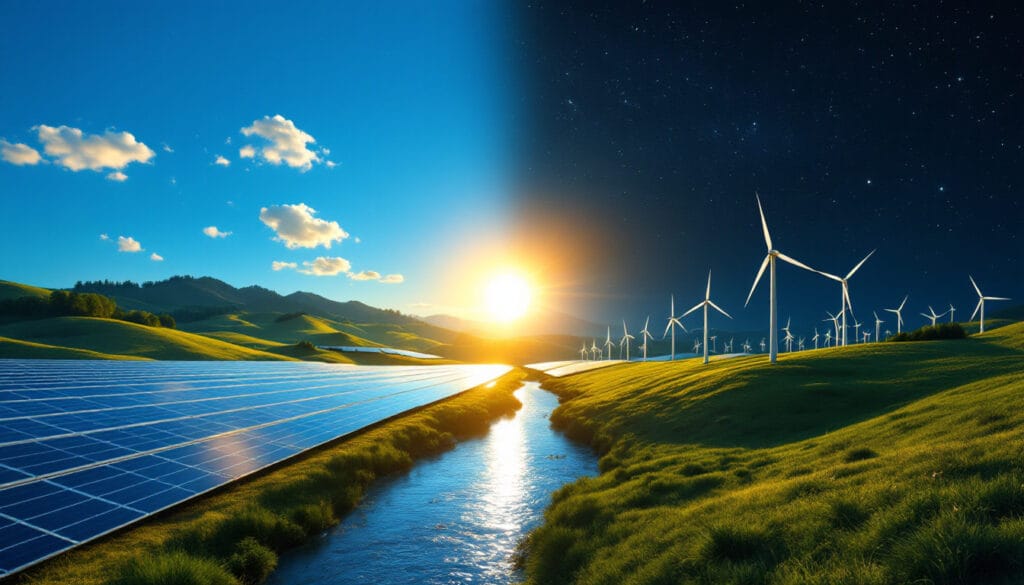Wind energy transforms the force of the wind into electricity through wind turbines. These devices harness the kinetic energy of the wind, causing their blades to rotate and driving a generator to produce energy. It provides a source of renewable energy that is non-polluting, playing a major role in the ecological transition. Presenting itself as a sustainable solution to reduce the carbon footprint, it is progressively integrating into our terrestrial landscapes with onshore wind farms. Its innovation capabilities and large-scale integration are at the heart of current energy strategies.
Wind Energy: Wind energy is a form of renewable energy that harnesses the power of the wind to produce electricity. By installing wind farms both on land and at sea, we access a clean and inexhaustible energy source, thereby contributing to better air quality and the fight against climate change.
Wind Turbine: A wind turbine is a machine designed to convert the kinetic energy of the wind into mechanical energy, and then into electricity. Wind turbines can be installed individually for domestic use or in groups in wind farms to generate large amounts of electricity.
Rotor: The rotor is a central element of the wind turbine, consisting of several blades. When the wind blows, it exerts a force on these blades, triggering a rotational movement essential for the operation of the wind turbine by driving a generator responsible for converting the movement into electricity.
Blades: The blades are the large dynamic structures attached to the rotor. Their aerodynamic design allows for maximizing wind energy capture. They are designed to withstand winds generally ranging from 10 to 90 km/h, but their rotation stops if the wind becomes too violent to prevent any potential damage.
Nacelle: The nacelle is the main compartment of the wind turbine, located at the top of the mast, which houses the rotor and the generator. A pivot system allows the nacelle to orient itself in the optimal direction of the wind, ensuring maximum electricity production.
Wind Farms: Wind farms, located either on land (onshore wind) or at sea (offshore wind), consist of several wind turbines. These installations allow for the production of a substantial amount of renewable electricity. Offshore wind, while requiring a more costly initial infrastructure, benefits from more consistent and powerful winds than those of onshore farms.
Intermittency: Wind energy is dependent on weather conditions and can be described as intermittent. In the absence of wind, wind turbines do not produce electricity. This necessitates resorting to energy storage solutions or combining different energy sources to ensure a continuous supply.
Advantages: One of the major benefits of wind energy is that it is both clean and renewable. It does not produce air pollutants or greenhouse gases, thus contributing to the reduction of the carbon footprint and the global energy transition. Furthermore, it generates local jobs and supports the local economy through investments in sustainable energy.
Innovations: Technological advancements are pushing the boundaries of wind energy. New designs of wind turbines, such as silent residential models, or energy optimization devices, increase efficiency and make this technology more accessible and competitive compared to other renewable energy sources.

FAQ – Understanding Wind Energy
Q: How does a wind turbine work?
A: A wind turbine converts the kinetic energy of the wind into electricity. The wind causes the blades of the rotor to spin, which in turn drives a generator thus producing electricity.
Q: What are the different configurations of a wind turbine?
A: The standard wind turbine consists of blades attached to a rotor. This rotor converts kinetic energy into mechanical energy, which is then transformed into electricity.
Q: At what speed do wind turbines operate?
A: Wind turbines generally operate at wind speeds ranging from 10 to 90 km/h. An orientation system allows the nacelle to follow the optimal wind direction.
Q: What are the advantages of wind energy?
A: Wind energy is a renewable and non-polluting source of energy that contributes to improving air quality. It is inexhaustible and helps reduce reliance on fossil fuels.
Q: What are the limits of wind energy?
A: Although wind energy is inexhaustible, it is intermittent as it depends on wind conditions. This therefore requires storage solutions or a mix with other energy sources.
Articles similaires
Thank you!
We will contact you soon.













